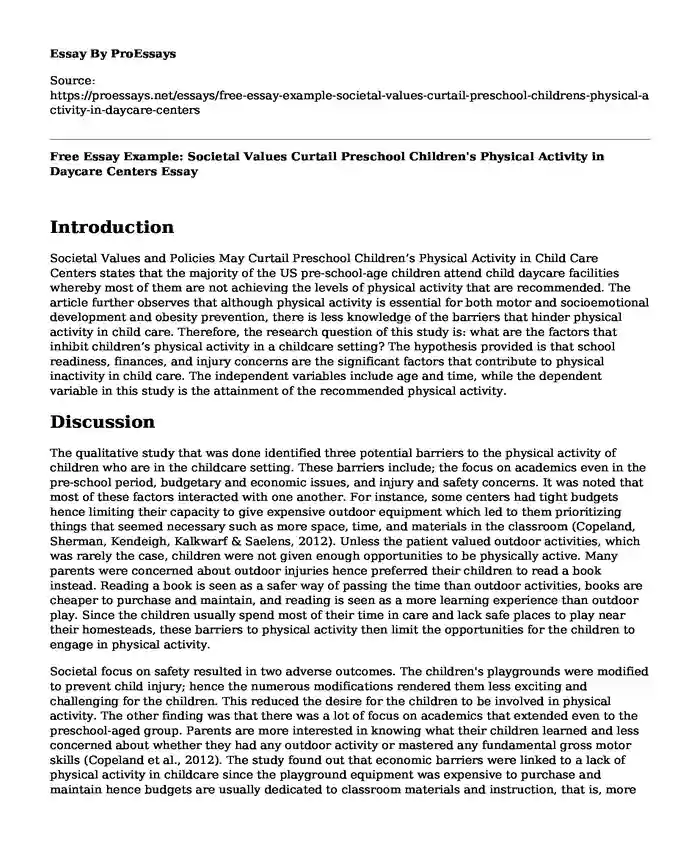Introduction
Societal Values and Policies May Curtail Preschool Children’s Physical Activity in Child Care Centers states that the majority of the US pre-school-age children attend child daycare facilities whereby most of them are not achieving the levels of physical activity that are recommended. The article further observes that although physical activity is essential for both motor and socioemotional development and obesity prevention, there is less knowledge of the barriers that hinder physical activity in child care. Therefore, the research question of this study is: what are the factors that inhibit children’s physical activity in a childcare setting? The hypothesis provided is that school readiness, finances, and injury concerns are the significant factors that contribute to physical inactivity in child care. The independent variables include age and time, while the dependent variable in this study is the attainment of the recommended physical activity.
Discussion
The qualitative study that was done identified three potential barriers to the physical activity of children who are in the childcare setting. These barriers include; the focus on academics even in the pre-school period, budgetary and economic issues, and injury and safety concerns. It was noted that most of these factors interacted with one another. For instance, some centers had tight budgets hence limiting their capacity to give expensive outdoor equipment which led to them prioritizing things that seemed necessary such as more space, time, and materials in the classroom (Copeland, Sherman, Kendeigh, Kalkwarf & Saelens, 2012). Unless the patient valued outdoor activities, which was rarely the case, children were not given enough opportunities to be physically active. Many parents were concerned about outdoor injuries hence preferred their children to read a book instead. Reading a book is seen as a safer way of passing the time than outdoor activities, books are cheaper to purchase and maintain, and reading is seen as a more learning experience than outdoor play. Since the children usually spend most of their time in care and lack safe places to play near their homesteads, these barriers to physical activity then limit the opportunities for the children to engage in physical activity.
Societal focus on safety resulted in two adverse outcomes. The children's playgrounds were modified to prevent child injury; hence the numerous modifications rendered them less exciting and challenging for the children. This reduced the desire for the children to be involved in physical activity. The other finding was that there was a lot of focus on academics that extended even to the preschool-aged group. Parents are more interested in knowing what their children learned and less concerned about whether they had any outdoor activity or mastered any fundamental gross motor skills (Copeland et al., 2012). The study found out that economic barriers were linked to a lack of physical activity in childcare since the playground equipment was expensive to purchase and maintain hence budgets are usually dedicated to classroom materials and instruction, that is, more focus and emphasis given to academics.
Conclusion
More children of the pre-school age spend most of their time in child daycare, whereby most of them do not achieve the levels of physical activity that are recommended. This issue has been attributed to; putting more importance on academics, school-readiness, finances, and injury concerns. More research is needed in the future to help in determining ways in which lessons on numbers and letters can be incorporated on the playgrounds hence meeting both the learning and the physical activity standards. There have been recent successful attempts aimed at integrating physical activity throughout the day in the classroom setting, especially among very young children who need physical activity more than classwork. Therefore, more research needs to be carried out to determine the extent of the success of these interventions through the evaluation of both cognitive and physical activity outcomes.
Reference
Copeland, K. A., Sherman, S. N., Kendeigh, C. A., Kalkwarf, H. J., & Saelens, B. E. (2012). Societal values and policies may curtail preschool children’s physical activity in childcare centers. Pediatrics, 129(2), 265-274. https://www.ncbi.nlm.nih.gov/pmc/articles/PMC3269117/
Cite this page
Free Essay Example: Societal Values Curtail Preschool Children's Physical Activity in Daycare Centers. (2023, Nov 20). Retrieved from https://proessays.net/essays/free-essay-example-societal-values-curtail-preschool-childrens-physical-activity-in-daycare-centers
If you are the original author of this essay and no longer wish to have it published on the ProEssays website, please click below to request its removal:
- Sociology Essay Example - Gender Stereotypes and Culture
- World View Interview Reflection
- Course in General Linguistics Essay
- Ethical Issues Surrounding the Use of Child Labor Around the World Essay
- Essay Sample on Intentional Teaching: Maximizing Children's Learning Outcomes
- Struggles of Oppression: Racial Self-Loathing Explored - Essay Sample
- Essay Example on A Student Outing Day: Unexpected Conflict Looms







